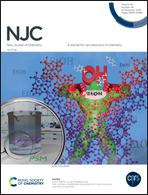Developing visible light responsive BN/NTCDA heterojunctions with a good degradation performance for tetracycline†
Abstract
In this paper, a series of BN/NTCDA photocatalysts have been prepared using a simple calcination method and their photocatalytic performance under visible light irradiation is studied with tetracycline (TC) as the target pollutant. When the ratio of BN and NTCDA is 100 : 1 and the temperature is 350 °C, the sample (BN/NTCDA (100 : 1)) has the highest adsorption efficiency (28.65%) and photodegradation efficiency (51.54%) for TC. The characterization results of XRD, FTIR, XPS, TEM, and 1H NMR show that BN/NTCDA (100 : 1) is a BN-based photocatalytic material, which is likely formed through the reaction of the surface hydroxyl group of BN and the anhydride of NTCDA. The band gap of BN is about 4.11 eV, and the band gap of NTCDA is 2.67 eV. So, the electron is firstly excited from the VB of NTCDA to its CB, and then the electron in the VB of BN is excited into the empty VB of NTCDA, implying that TC is degraded by photoactive species (˙O2−, h+ and ˙OH) from the VB of BN and CB of NTCDA. The capture experiment of photoactive species suggests that ˙O2− makes the main contribution to TC photodegradation, followed by h+, ˙OH. After five recycle experiments, BN/NTCDA (100 : 1) still has 77.32% removal efficiency for TC. The removal efficiency (80.19%) of BN/NTCDA (100 : 1) is higher than that of TiO2 (75.63%) and g-C3N4 (24.44%). This work contributes to the development of novel metal-free-photocatalysts and the application of photocatalytic technology to the removal of antibiotics.



 Please wait while we load your content...
Please wait while we load your content...